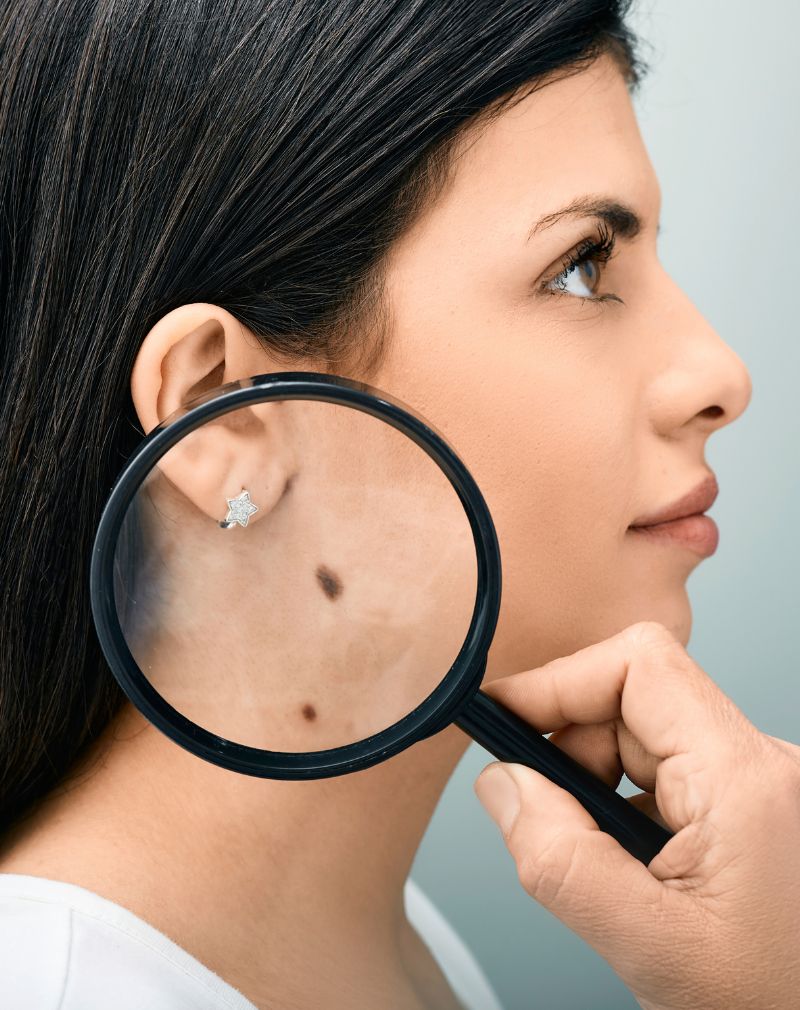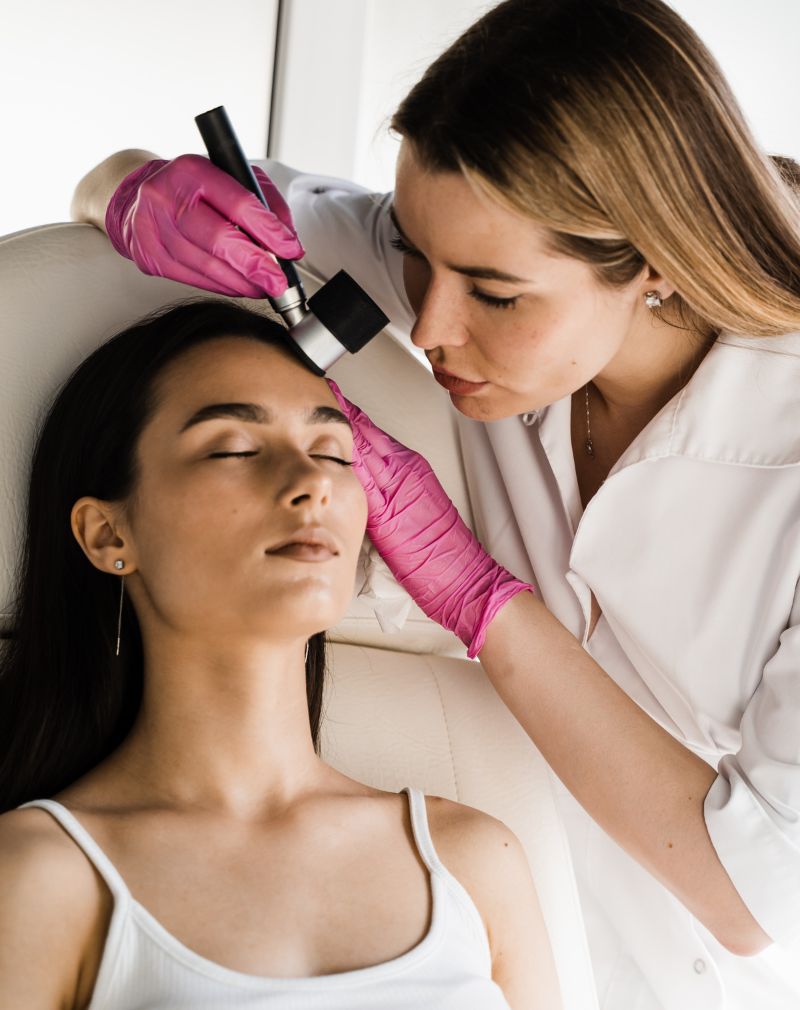Moles, or nevi, are common skin growths made up of melanocytes, the cells that produce pigment. They can appear anywhere on the skin, alone or in groups, and vary in color, shape, and size. Most moles are benign, but some may change over time and require medical evaluation.
Mole mapping and diagnostic biopsy of moles are critical components in the early detection and treatment of skin cancer, particularly melanoma, which is the most dangerous form of skin cancer. Understanding why it’s essential to investigate unusual moles, the potential for moles to become cancerous, the impact of early diagnosis on treatment plans, the signs indicating the need to see a dermatologist, and the role of a dermatologist in mole mapping, is vital for maintaining skin health and preventing advanced skin cancer.
While most moles are benign, certain changes in their appearance can indicate the development of melanoma. Investigating unusual moles is crucial because early detection of melanoma can significantly improve treatment outcomes. When melanoma is detected early, it is almost always curable. However, if left undetected, melanoma can advance and spread to other parts of the body, making it more difficult to treat.
Can Moles Be Cancerous?
Yes, moles can be cancerous. Melanoma can develop in an existing mole or appear as a new dark spot on the skin. Factors that may increase the risk of a mole becoming cancerous include a family history of melanoma, having a large number of moles, and exposure to ultraviolet (UV) radiation from the sun or tanning beds. The dysplastic nevus syndrome, which involves having large, irregularly shaped, and unevenly colored moles, also increases the risk of developing melanoma.
The Impact of Early Diagnosis on Treatment Plans
Early diagnosis of melanoma is crucial for effective treatment. When melanoma is caught early, surgical removal of the tumor is often all that’s needed. This procedure has a high success rate and typically leads to a complete cure. However, if melanoma is not detected until it has advanced, treatment becomes more complex and may involve surgery, immunotherapy, radiation therapy, and chemotherapy. Thus, early diagnosis not only increases the likelihood of successful treatment but also minimizes the need for more aggressive and potentially debilitating treatments.
What are the risk factors
- Sun Exposure: Extensive exposure to sunlight, particularly UV rays, increases the risk of moles becoming cancerous.
- Genetics: A family history of skin cancer or moles can elevate the risk.
- Skin Type: Individuals with fair skin, light hair, and blue or green eyes have a higher susceptibility.
- Number of Moles: Having more than 50 ordinary moles increases melanoma risk.
- Atypical Moles: Possessing unusual (dysplastic) moles that are large and irregular in shape.
- Weakened Immune System: Conditions or medications that suppress the immune system can heighten risk.
- Age: Risk increases with age, though moles can develop at any age.
Signs That Indicate You Should See a Dermatologist
It’s essential to be aware of the signs that indicate the need to consult a dermatologist for a mole evaluation. The ABCDEs of melanoma provide a useful guide:
- **A**symmetry: One half of the mole does not match the other half.
- **B**order: The mole has irregular, blurred, or notched borders.
- **C**olor: The mole has varying colors, including shades of brown, black, red, white, or blue.
- **D**iameter: The mole is larger than 6mm in diameter (about the size of a pencil eraser), although melanomas can be smaller.
- **E**volving: The mole changes in size, shape, color, or height, or a new symptom such as bleeding, itching, or crusting appears.
Benefits of Mole Mapping
Mole mapping offers significant advantages, particularly for individuals who have numerous moles or moles in areas difficult to see, such as the back and shoulders. This task becomes even more challenging for those with mobility issues. In the UK alone, around 175,000 new skin cancer cases are diagnosed annually, many of which could be prevented through early detection and removal of changing skin lesions. Individuals with a history of skin cancer or those at increased risk are advised to regularly check their skin for suspicious growths, which can often manifest within moles. By monitoring these changes, early intervention becomes possible, enhancing the likelihood of a successful treatment and minimizing the risk of scarring.
Not all skin cancers arise from moles; freckles and other seemingly harmless marks can also develop into cancer, making self-checks insufficient for identifying suspicious growths that might resemble normal skin. Mole mapping utilizes high-quality imaging far superior to standard high-resolution photos, capturing extremely detailed photographs that allow dermatologists to zoom in up to 140x. This level of magnification provides a detailed view of any mole, mark, or suspicious growth, enabling precise monitoring and early detection of skin changes that could indicate cancer.
Role of a Dermatologist in Mole Mapping
Dermatologists play a crucial role in the early detection of melanoma through mole mapping. Mole mapping involves taking detailed images of the moles on your body and creating a baseline map. This map is then used for comparison during future visits to detect new moles or changes in existing ones. Dermatologists are trained to identify suspicious moles that may require further investigation through a diagnostic biopsy. In a biopsy, a small sample of the mole is removed and examined under a microscope for cancer cells. The dermatologist can then recommend the appropriate treatment based on the biopsy results.
In regions with high UV exposure, where intense sunlight and scarce cloud cover prevail, the risk of skin conditions like moles and melanoma significantly escalates. This risk is particularly acute in areas with longer hot summer weather , close to the equator or at elevated altitudes, where the sun’s rays are more direct and prolonged daylight extends exposure times. Such environments necessitate stringent sun protection strategies, including the application of broad-spectrum sunscreen, wearing sun-protective clothing, and seeking shade whenever possible. Moreover, the importance of regular skin examinations are highly recommended, as early detection of any new or changing moles can be crucial for timely intervention. Adhering to these precautions is essential for minimizing the risk of skin damage and associated conditions in sun-dominant climates.
Why choose American Wellness Center
We, at American Wellness Center, are located in the Dubai Healthcare City (DHCC), we recognize the critical importance of skin health, particularly in the challenging climate of the UAE. Our UK-qualified consultant dermatologist and MOHE Surgeon is not only fully certified in the UK but also holds a Dubai Health Authority (DHA) certification, ensuring the highest standards of care and expertise. Understanding the heightened risk of skin-related issues in our region, he provides comprehensive patient care that takes into account the unique environmental factors of the UAE. From advanced mole mapping to preventative consultations and treatment of skin conditions, our specialist employs a meticulous approach to dermatology that emphasizes early detection and personalized treatment plans. His expertise, coupled with a deep understanding of the impact of the UAE’s weather on skin health, ensures our patients receive the most effective and informed care possible at the American Wellness Center.

